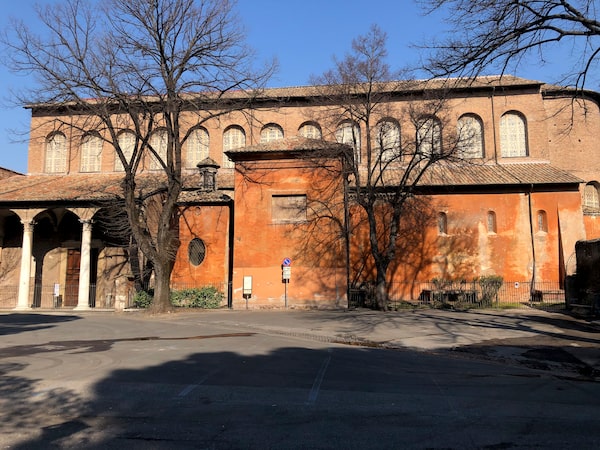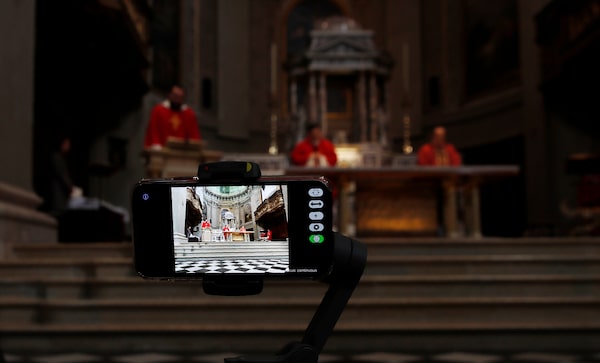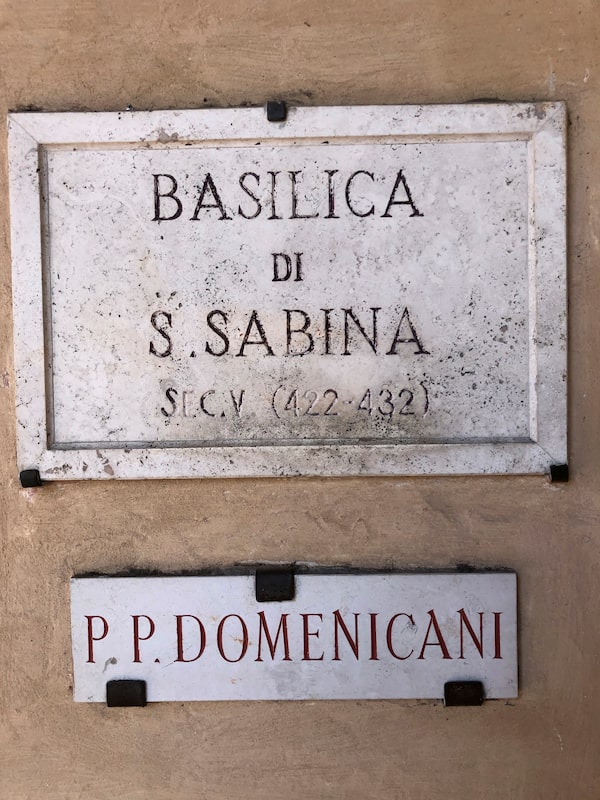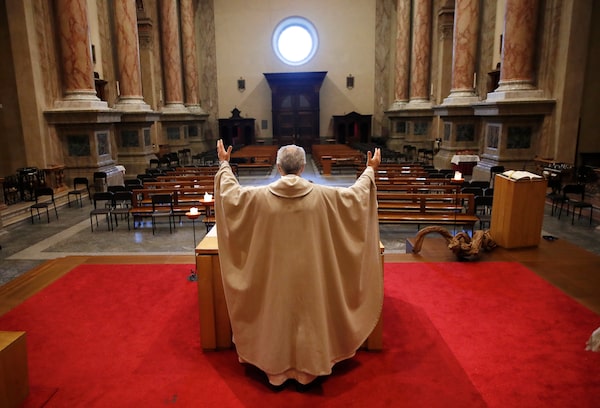Pope Francis leads the Good Friday Passion of the Lord in St. Peter's Basilica with no public participation due to the outbreak of the coronavirus disease (COVID-19), at the Vatican, April 10, 2020.POOL/The Associated Press
The Basilica of Santa Sabina on Rome’s ancient Aventine Hill is a religious, architectural and historical marvel. Built in the early fifth century, when the Western Roman Empire was being ransacked by the Visigoths, it has survived plague, pestilence, foreign occupations and war.
We don’t know if it has ever closed its doors – the historical records of Rome’s churches don’t go into that much detail. We can assume that, in modern times, what is about to happen will be unprecedented: Santa Sabina will not open its doors on Easter Sunday, the holiest day in the holiest week of the Roman Catholic calendar.
Eric Reguly's plague diary: Seven weeks of Italy’s coronavirus crisis, as seen from a distance
Santa Sabina, like all other churches in Italy, has fallen victim to the new plague – the novel coronavirus. When Prime Minister Giuseppe Conte locked down Italy on March 9, every church in the land, including St. Peter’s Basilica in the Vatican, went into bunker mode too.
Italy’s loveliest churches tend to attract hordes of visitors, if not worshippers, and neither Mr. Conte nor Pope Francis wants to see them turn into COVID-19 hotspots. The good Lord would not approve.

Lateral view of Santa Sabina basilica in Rome, the home church of Rome correspondent Eric Reguly, photographed on April 9, 2020 in the midst of the Covid-19 virus outbreak in Italy that will see the churches empty this Easter.Eric Reguly
But no open churches doesn’t mean no masses on Sunday. The savviest priests, such as Pope Francis himself, are going digital, with online masses delivered to the housebound faithful via Facebook or YouTube. Whoever runs the Duomo cathedral in Milan, the northern Italian city at the epicentre of the European COVID-19 crisis, might be the savviest of them all. To guarantee a global audience, the Italian tenor Andrea Bocelli will hold a concert in the empty cathedral on Sunday night. It will be live streamed on his YouTube channel.
All of which seems rather unspiritual to me – no incense, no holy water nor candles, no pre-mass confessions in those little wooden booths, none of the “smells and bells,” to borrow a term favoured by the British Anglicans, that can turn a high mass in a musty old church into a soul-stirring experience, especially if the priest and his choir have good pipes.
Michael Czerny, Canada’s newest cardinal, tells me I am wrong, even if he is not happy that Italy’s Catholics, which is to say the vast majority of Italians, can’t visit their traditional places of worship this Easter.
Donors, greenhouses join forces to share Easter flowers
As some U.S. evangelical churches defy stay-at-home directives, others switch to online services
“Of course it’s a blow,” he tells me in a phone call. “It’s a real loss on one hand. On the other hand, we have always said the church is not principally a building. We will still worship together in spirit and in truth. The unity of prayer will bind us together on Easter. We don’t have to be inside four walls.”
Cardinal Czerny, 73, is a street-smart Jesuit priest who is Under-Secretary for Migrants and Refugees for the Holy See. Pope Francis fast-tracked him into the ranks of the cardinals in October and he enjoys a close relationship with the Pope, who is also a Jesuit.
He makes a good point to me that I had forgotten: The church has always been a prolific user of electronics to reach the faithful around the world. So the virtual Easter masses, while a novelty for Italians, are routine for millions of Catholics in far-flung corners of the world, such as China.

A priest wearing a mask and gloves celebrates Mass at the Ospedale di Circolo in Varese, Italy, Friday, April 10, 2020.Luca Bruno/The Associated Press
“In a sense, Catholics have lived their faith thanks to the Vatican Radio’s transmissions,” Cardinal Czerny says.
Guglielmo Marconi, the Italian electrical engineer who is credited with inventing radio communications, set up Vatican Radio in 1931. Today, the service – “The voice of the Pope and the church in dialogue with the world” – is a global broadcasting force available in 39 languages through radio, web channels, satellite and podcasts.
Still, the dwindling number of Italians and other Europeans who occasionally go to church on Sundays and almost always at Easter (as I do – my annual insurance run) will find it strange fiddling with computers to watch their parish priest in digital action, assuming the old guy even knows how to set up a live stream.
And what if you want to make a confession when no priests are available? Pope Francis has an answer for that, which amounts to a do-it-yourself program. In a live-streamed mass on March 20, he said, “But many people would tell me, ‘Father, where can I find a priest, a confessor, because I can’t leave the house?”

A smartphone films priests praying during the Passion of Christ Mass on Good Friday inside the Santissima Redentore church in Seriate, near Bergamo, one of the areas worst hit by coronavirus, Northern Italy, Friday, April 10, 2020.Antonio Calanni/The Associated Press
Pope Francis said his response would be: “It is very clear. If you cannot find a priest to confess to, speak directly with God, your father, and tell him the truth. Say, ‘Lord, I did this, this, this. Forgive me,’ and ask for pardon with all your heart.”
That would work for me. But how many Hail Marys would my contrition demand?
My neighbourhood, the Aventine, which includes the adjacent San Saba hill, is home to some of the oldest and loveliest churches in Christendom. The Aventine is one of Rome’s seven ancient hills and slopes down to the Circus Maximus – think Ben Hur.
I put on a face mask and rubber gloves and go on a church tour alone, in rather open defiance of the quarantine – outings are supposed to be limited to “essential” missions. The Basilica of San Saba, completed in the 13th century and noted for its elaborate Cosmatesque marble floors and 12th-century frescoes of St. Nicholas, is entirely closed, even the courtyard. A sign taped to the wall instructs me to visit the church’s Facebook page if I want to watch a mass.
Next up is the lovely little church of Santa Prisca, which is recorded as Titulus Priscae in the Vatican’s 499 synod and sits over the amazingly intact remnants of an ancient Mithraic temple. A taped sign on the door directs me to a YouTube channel for its Easter mass.

Plaque showing 5th Century construction date of Santa Sabina basilica in Rome, the home church of Rome correspondent Eric Reguly; photographed April 9, 2020 in the midst of the Covid-19 virus outbreak in Italy that will see the churches empty this Easter.Eric Reguly/The Globe and Mail
Nearby is Santa Sabina, my favourite – also closed. It is one of the oldest churches in the Christian world, built in 425. Its austere, Romanesque design has charmed generations of architects, artists, historians and popes, who, for many centuries, have celebrated Ash Wednesday in its simple, soaring interior.
Sabina was a Roman matron who was converted to Christianity by her Greek slave; both were martyred in the reign of Emperor Hadrian (117-138). The church was built on the site of her palace. The 24 white fluted columns in the nave probably came from the Temple of Juno, which stood on the same site. The fifth-century reliefs on the main doors, made of cedar, include one of the first known depictions of the crucifixion of Christ. There is no cross; he and the two thieves hang from wooden beams.
I make it my mission to find out if the COVID-19 crisis marks the first time Santa Sabina has closed. I buzz the door of the rectory, where the Dominican priests live. There is no answer, no sign of human activity anywhere.
So I turn to my friend Matthew Kneale, a British author and formidable history researcher who lives in Rome and who recently wrote a book called Rome: A History in Seven Sackings. He doesn’t know for sure if Santa Sabina had ever closed, but suspects it has.

In this Thursday, April 2, 2020 file photo, Don Angelo Riva celebrates a mass in an empty church in Carenno, Italy.Antonio Calanni/The Associated Press
He notes that the church existed during the Justinian Plague in the mid-sixth century. But there were no records of what happened in Roman churches at the time, he says, nor during the Black Death itself in the 1340s – the most devastating pandemic. “I imagine it would have closed in 1527, when Rome was attacked by the Lutheran German-Spanish-Italian army of Charles V and numerous priests and monks were attacked, murdered and castrated,” he says.
I take his word for it, so let’s agree that Santa Sabina’s closure (and that of other churches) is an exceedingly rare event, like once or twice in a millennium. In that sense, Easter Sunday’s closed-door, virtual masses are ones for the history books.
After visiting Santa Sabina, I run into two nuns – one Brazilian, one Spanish – on the Aventine. They belong to the Daughters of the Heart of Mary and live in a big convent nearby. Wearing gloves but no masks, they are taking out the garbage. The Spanish nun, Sister Maria Del Valle, 57, says she is sad that they cannot celebrate a traditional mass on Sunday, though they will have a small mass in their chapel, where physical-distancing rules will be enforced.
Pope Francis leads the Via Crucis (Way of the Cross) procession during Good Friday celebrations at St. Peter's Square with no public participation due to an outbreak of the coronavirus disease (COVID-19) in Vatican, April 10, 2020.YARA NARDI/Reuters
She takes Cardinal Czerny’s view. “Our religion is not a building. It will just be a different week for us. We have to respect the rules to save lives," she says.
Support for the church lockdown in not universal. One prominent opponent is Matteo Salvini, leader of Italy’s far-right, populist League party, which was in government until last September, when its coalition with the Five Star Movement collapsed. He is often photographed rather theatrically kissing or clutching a rosary and has been lobbying the government to open the churches for Easter in spite of the coronavirus lockdown.
Italians, he says, “need a moment of hope. ... Science alone is not enough; the good Lord is also needed.”
He will not get his wish, because the Vatican and the government are united in the fight against the disease and that means priests everywhere will be setting up video gadgets next to their pulpits.
“We support what governments are doing and we encourage our people to co-operate,” says Cardinal Czerny. “The church is following the rules and, within the rules, we are finding new ways to pray, to console and to reconcile.”
 Eric Reguly
Eric Reguly